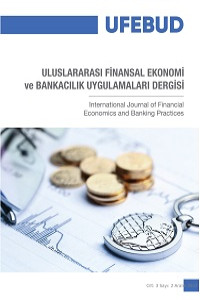Abstract
Bu çalışmanın amacı, bilgi rasyosunun kolektif yatırım kuruluşlarından birisi olan bireysel emeklilik fonlarının emsal-grup performansı (getiri) için iyi bir gösterge olup olmadığını analiz etmektir. Bireysel emeklilik fonu piyasasının toplam aktifleri ve mevzuat açısından en önemli parçası olan 12 standart fon için, 2018-2021 dönemi yıllık Bilgi Rasyosu ve Emsal Grup Getiri verilerini kullanıyoruz. Bu çalışma sadece Gönüllü Katılım Sistemi'ndeki (BES-Bireysel Emeklilik Sistemi) standart emeklilik fonlarını kapsamaktadır. Nicel analizin bulguları şu şekildedir; Gönüllü BES-Standart Fonları kapsamında, 2018, 2019, 2020 ve 2021 yılları için, emsal grup getiri sıralaması (yani fon performansı) ile Bilgi Rasyosu sıralaması arasında önemli bir ilişki yoktur. Bu çalışma, bilgi rasyosunun temel bir performans göstergesi olmasına rağmen, bu oranın -özellikle emeklilik fonlarının performansı raporlanırken- tek kriter olarak değerlendirilmemesi gerektiğini öne sürmektedir.
References
- Arora, K. (2015). The Information Ratio on Indian Mutual Funds. Bharati IMSR Journal, 7 (1): 34-42.
- Bowie, D.C., Cumberworth, M., Haig, A., & Nelson, B. (2001). The Practicalities of Budgeting, Managing and Monitoring Investment Risk for Pension Funds. Finance and Investment Conference Proceedings.
- Gupta, F., Prajogi, R. and Stubbs, E. 1999. The Information Ratio and Performance. The Journal of Portfolio Management, 26 (1) 33-39; DOI: https://doi.org/10.3905/jpm.1999.319779.
- Hallerbach, W. G. (2005). The Information Ratio as a Performance Metric. Available at SSRN: https://ssrn.com/abstract=1425527 or http://dx.doi.org/10.2139/ssrn.1425527.
- Hübner, G. (2007). How Do Performance Measures Perform? The Journal of Portfolio Management, 33 (4): 64-74.
- Kahn, R.N. and Rudd, A. 1995. Does Historical Performance Predict Future Performance? Financial Analysts Journal, 51(6).
- Karataş, İ., İslamoğlu, M. (2021) Ulusal ve küresel makroekonomik faktörlerin gelişen borsalar üzerindeki etkileri: Türkiye ve BRICS ülkeleri üzerine ampirik bir araştırma, BMIJ, 9 (4): 1611-1639.
- Lattimore, T. and Gyorgy, A. (2021). Mirror Descent and the Information Ratio. Proceedings of Thirty Fourth Conference on Learning Theory, Proceedings of Machine Learning Research, 134:2965-2992.
- Lundin, Mark. (2004). On the information ratio of tactical asset allocation. Journal of Asset Management. 4. pp. 326-333. 10.1057/palgrave.jam.2240113.
- Muralidhar, A. (2005). Why maximising information ratios is incorrect. Derivatives Use, Trading Regulation. 11. 233-244. 10.1057/palgrave.dutr.1840021.
- Philippe, B. and Protopopescu, P.C. (2010). The Statistics of the Information Ratio. International Journal of Business, 15 (1), Available at SSRN: https://ssrn.com/abstract=2666519 or http://dx.doi.org/10.2139/ssrn.2666519
- Qian, E. and Hua, R. (2004). Active Risk and Information Ratio. Journal of Investment Management, 2(3): 1-15.
- Oran, J. S., Avci, E. , Ashoor, M. & Tan, O. F. (2017). An Evaluation of Turkish Mutual And Pension Funds’ Performances. Press Academia Procedia, 3 (1): 131-142.
- Internet Sources CMB. Capital Markets Board of Turkey. http://www.cmb.gov.tr
- TEFAS. Turkey Electronic Fund Trading Platform. http://www.tefas.gov.tr
- KAP. Public Disclosure Platform. https://www.kap.org.tr
- Emeklilik Yatırım Fonlarına İlişkin Rehber (Guide for Pension Funds), (CMB), 2016.
- https://corporatefinanceinstitute.com/resources/knowledge/finance/information-ratio/
- https://www.investopedia.com/terms/i/informationratio.asp
- https://www.egm.org.tr/voluntary-participation-ips/what-is-ips/
Abstract
The aim of this paper is to analyze whether information ratio (IR) is a good indicator for peer group performance (returns) of private pension funds, which are collective investment institutions. We employ annual data of IR and Peer Group Returns for the period between 2018 and 2021 for 12 standard funds that are the most significant part of private pension fund market with respect to total asset under management and also regulations. This study covers only standard pension funds in Voluntary Participation System (IPS-Individual Pension System). Findings indicate that for the years 2018, 2019, 2020 and 2021, there is no significant relation between ‘Peer-Group Return Ranking’ and ‘Information Ratio Value Rankings’ for IPS-Standard Funds. The paper suggests that although IR is a pivotal performance indicator, this ratio should not be considered as the single criterion -especially while reporting the performance of the pension funds-.
References
- Arora, K. (2015). The Information Ratio on Indian Mutual Funds. Bharati IMSR Journal, 7 (1): 34-42.
- Bowie, D.C., Cumberworth, M., Haig, A., & Nelson, B. (2001). The Practicalities of Budgeting, Managing and Monitoring Investment Risk for Pension Funds. Finance and Investment Conference Proceedings.
- Gupta, F., Prajogi, R. and Stubbs, E. 1999. The Information Ratio and Performance. The Journal of Portfolio Management, 26 (1) 33-39; DOI: https://doi.org/10.3905/jpm.1999.319779.
- Hallerbach, W. G. (2005). The Information Ratio as a Performance Metric. Available at SSRN: https://ssrn.com/abstract=1425527 or http://dx.doi.org/10.2139/ssrn.1425527.
- Hübner, G. (2007). How Do Performance Measures Perform? The Journal of Portfolio Management, 33 (4): 64-74.
- Kahn, R.N. and Rudd, A. 1995. Does Historical Performance Predict Future Performance? Financial Analysts Journal, 51(6).
- Karataş, İ., İslamoğlu, M. (2021) Ulusal ve küresel makroekonomik faktörlerin gelişen borsalar üzerindeki etkileri: Türkiye ve BRICS ülkeleri üzerine ampirik bir araştırma, BMIJ, 9 (4): 1611-1639.
- Lattimore, T. and Gyorgy, A. (2021). Mirror Descent and the Information Ratio. Proceedings of Thirty Fourth Conference on Learning Theory, Proceedings of Machine Learning Research, 134:2965-2992.
- Lundin, Mark. (2004). On the information ratio of tactical asset allocation. Journal of Asset Management. 4. pp. 326-333. 10.1057/palgrave.jam.2240113.
- Muralidhar, A. (2005). Why maximising information ratios is incorrect. Derivatives Use, Trading Regulation. 11. 233-244. 10.1057/palgrave.dutr.1840021.
- Philippe, B. and Protopopescu, P.C. (2010). The Statistics of the Information Ratio. International Journal of Business, 15 (1), Available at SSRN: https://ssrn.com/abstract=2666519 or http://dx.doi.org/10.2139/ssrn.2666519
- Qian, E. and Hua, R. (2004). Active Risk and Information Ratio. Journal of Investment Management, 2(3): 1-15.
- Oran, J. S., Avci, E. , Ashoor, M. & Tan, O. F. (2017). An Evaluation of Turkish Mutual And Pension Funds’ Performances. Press Academia Procedia, 3 (1): 131-142.
- Internet Sources CMB. Capital Markets Board of Turkey. http://www.cmb.gov.tr
- TEFAS. Turkey Electronic Fund Trading Platform. http://www.tefas.gov.tr
- KAP. Public Disclosure Platform. https://www.kap.org.tr
- Emeklilik Yatırım Fonlarına İlişkin Rehber (Guide for Pension Funds), (CMB), 2016.
- https://corporatefinanceinstitute.com/resources/knowledge/finance/information-ratio/
- https://www.investopedia.com/terms/i/informationratio.asp
- https://www.egm.org.tr/voluntary-participation-ips/what-is-ips/
Details
| Primary Language | English |
|---|---|
| Subjects | Business Administration |
| Journal Section | Research Articles |
| Authors | |
| Publication Date | December 31, 2022 |
| Published in Issue | Year 2022 Volume: 3 Issue: 2 |


